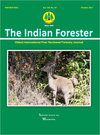Some Observations on the Breeding of Chitals (Axis axis) in the Deer Park of Navegaon National Park
DOI:
https://doi.org/10.36808/if/2017/v143i10/119371Keywords:
Breeding, Chital, Navegaon Park.Abstract
The paper describes observations about breeding of chital or spotted deer Axis axis at deer park in Navegaon National Park, (Dist. Gondia, Maharashtra) during 1970-90. The observations of 144 births indicates that chital breed only once in a year, mostly from November to February. The animal avoids breeding in peak summer i.e. May when the temperature soars to 42°C and also during rainy season i.e. June- September. The sex ratio of male to female was observed to be 1:1.References
Champion H.G. and Seth S.K. (1968). A revised survey of forest type of India, Govt. of India Press. New Delhi, p.404.
Mishra H.R. (1982). The ecology and behaviour of Chital (Axis Axis) in the Royal Chitwan National Park, Nepal. (With Comparative Studies of Hogdeer (Axis porctnus), Sambar (Cervus unicolor) and Barking deer (Muñtiacus muntjak)) A dissertation submitted for a degree in Doctor of Philosophy, October-1982 to University of Edinburgh.
Prater S.H. (1971). Book of Indian Animals, (pp.281, 285). The chital (pp292-293).
Ramesh T. (2010).Group size, sex and age composition of chital (Axis axis) and sambar (Cervus unicolor) in a deciduous habitat of Western Ghats, Article in Mammalian Biology - Zeitschrift fur Saugetierkunde. 77(1):53–9.
Sankar K. and Acharya B. (2004).Ungulates of India, Spotted deer or Chital, ENVIS, 7(1): 2004.
Schaller G.B. (1998). The deer and the tiger, Natraj publishers, Dehradun, (First Indian edition) pp.37-92.
Srinivasulu C. (2001). Chital (Axis Axis Erxleben,1777) herd composition and sex ratio on The Nallamala Hills of Eastern ghats, Andhra Pradesh, India. Zoos' Print Journal, 16(12): 655-658.
Downloads
Downloads
Published
How to Cite
Issue
Section
License
Unless otherwise stated, copyright or similar rights in all materials presented on the site, including graphical images, are owned by Indian Forester.





